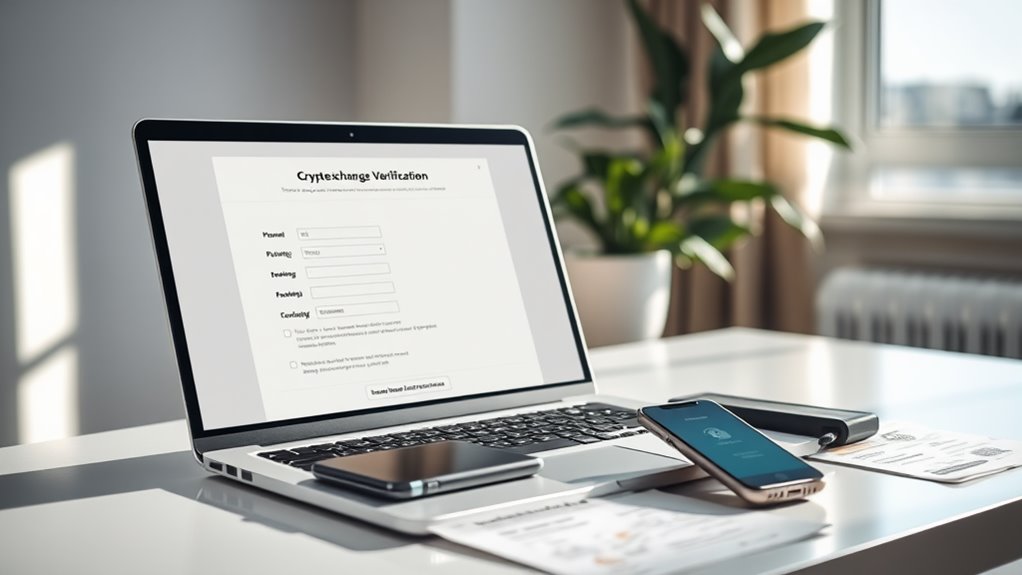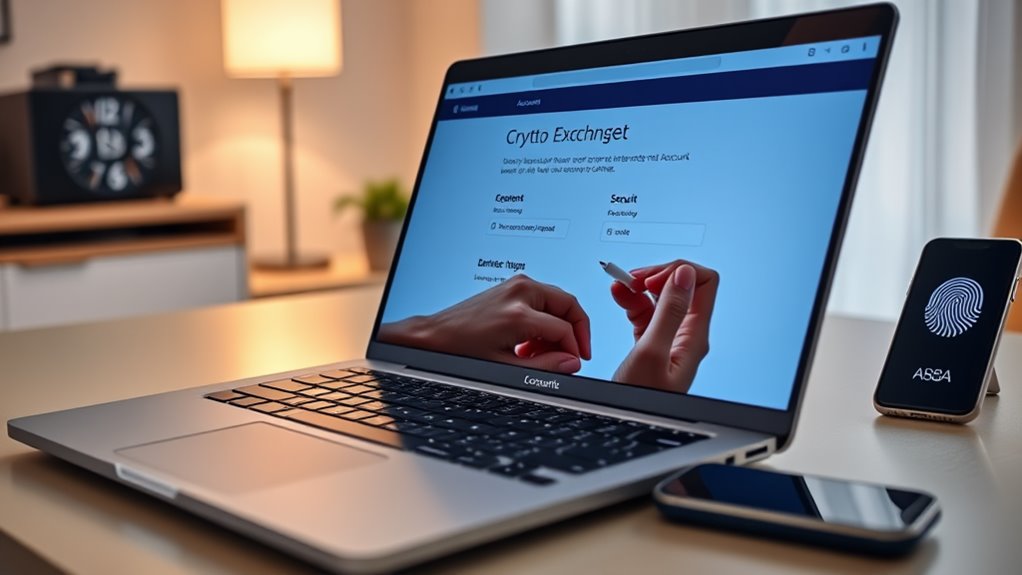
How to Create a Crypto Exchange Account: A Step-by-Step Guide
To create a crypto exchange account, first select a reputable platform that guarantees robust security and is user-friendly. Register by providing an email address and creating a password, followed by verifying your identity through document submissions, such as a government-issued ID. Configure strong security measures like multi-factor authentication, then deposit funds using bank transfers, credit cards, or e-wallets. Start trading by exploring various tools like CFDs and leveraged trading. For detailed insights on withdrawals and advanced trading tools, continue exploring further.
Key Takeaways
- Choose a reputable crypto exchange with strong security measures and regulatory compliance.
- Complete registration by providing an email, creating a password, and verifying your identity with required documents.
- Set up robust security practices including multi-factor authentication and secure internet connections.
- Deposit funds using preferred methods like bank transfers, credit cards, or cryptocurrency transfers.
- Begin trading by understanding and utilizing tools like CFDs, leveraged trading, and setting up stop-loss and limit orders.
Selecting the Most Suitable Crypto Exchange

Why should one be meticulous when selecting a crypto exchange? Choosing the right platform guarantees robust security, a user-friendly interface, variety in cryptocurrencies, reasonable fees, and reliable regulatory compliance.
A good exchange employs two-factor authentication, uses cold storage for funds, and protects data with strong encryption techniques. These features minimize the risk of hacks and safeguard user assets.
Additionally, platforms with intuitive interfaces, customizable options, and real-time data make trading more accessible and informed. Regulatory adherence and a clean history indicate stability and trustworthiness, attracting discerning traders.
Intuitive platforms with customizable trading options foster accessibility and well-informed decisions, ensuring a trustworthy trading environment.
Finally, transparent and competitive fee structures prevent unexpected costs, enhancing trading profitability. Consequently, careful selection is pivotal for secure, efficient, and compliant cryptocurrency trading.
Traders should also understand the differences between centralized and decentralized exchanges, as this decision can significantly impact their trading strategy and risk exposure.
Registering Your Account

When creating a crypto exchange account, users begin by entering their email, selecting a secure password, and confirming their email address by clicking on a link.
This initial sign-up process is followed by steps to verify their identity, including phone number verification and submitting various documents as required by Know Your Customer (KYC) regulations.
These stages are essential for securing the account and ensuring compliance with legal standards.
Initial Sign-Up Process
To initiate the registration for a new crypto exchange account, one must first download and install the appropriate mobile application, available for both iOS and Android systems.
Prospective users can locate the app on either the App Store or Google Play. Once installed, launching the app will lead to a sign-up section where the initial registration process begins. It is essential to maintain a stable internet connection throughout this phase.
During registration, basic information such as an email address is required. Upon providing this, a confirmation link is sent to the email. The user must then create a strong, unique password and accept the preliminary terms of service to proceed further.
Choosing the right exchange is crucial, as factors like security measures and fee structures significantly impact your trading experience.
Identity Verification Steps
After completing the initial sign-up and having access rights secured through a strong password and agreement to the terms of service, the next step involves identity verification, a foundational aspect of registering a new crypto exchange account.
| Verification Task | Description |
|---|---|
| Document Submission | Scan and upload government IDs and proof of residence. |
| Facial Recognition | Use facial recognition software to verify the identity matches the documents provided. |
| Liveness Detection | Perform actions, such as blinking, to confirm presence and authenticity. |
This process not only adheres to AML and KYC regulations, enhancing security, but also builds trust by ensuring all users are verified, thereby protecting against potential fraud and reducing financial risks.
Completing Verification Process

As part of the verification process when creating a crypto exchange account, users are required to submit various forms of KYC documentation, such as government-issued IDs and proof of address.
These steps are essential for ensuring compliance with anti-money laundering regulations and safeguarding against fraudulent activities.
The details of these verification steps vary depending on the specific requirements of the exchange and jurisdictional laws, which must be followed precisely to activate and maintain the account.
KYC Documentation Needs
Completing the verification process for a crypto exchange account necessitates the submission of specific KYC (Know Your Customer) documentation to meet legal and regulatory demands.
Here are the essential documents:
- Government-issued ID: Including passports, driver's licenses, or national ID cards, which serve as a proof of identity.
- Proof of Address: Utility bills, bank statements, or signed rental agreements confirming the residential address.
- Biometric Verification: Selfies or live photos for facial recognition, ensuring the person creating the account is present.
- Personal Details: Submission of full name, date of birth, and residential address, alongside contact information such as email address and phone number.
These measures help in adhering to AML and CFT regulations.
Verification Step Details
Having outlined the types of documents required for KYC compliance in crypto exchange accounts, we can now examine the steps involved in completing the verification process.
Initially, users create an account and verify their email through a provided link. Next, they must secure their account by enabling two-factor authentication, enhancing their protection against unauthorized access.
For more rigorous identification, exchanges might require facial recognition, real-time selfies with identification documents, and liveness detection to guarantee the person's physical presence. All these submissions are reviewed by the verification team.
Typically, this review process spans a few hours to several business days. Following approval, users gain access to full account functionalities, including trading and funding options.
Setting Up Security Measures

To guarantee the security and integrity of your crypto exchange account, several key steps should be taken.
Key Security Measures:
- Use Strong Passwords: Employ a password manager to generate and store complex, unique passwords for your exchange account, enhancing security against unauthorized access.
- Enable Multi-Factor Authentication (MFA): Add an additional layer of security by setting up MFA, such as 2FA, which requires more than one form of identification before accessing your account.
- Beware of Phishing: Stay vigilant against phishing attempts. Do not disclose your login information in response to unsolicited emails or messages.
- Secure Connectivity: Avoid using public Wi-Fi for managing your crypto transactions due to potential security vulnerabilities.
Always keep your software updated to protect against vulnerabilities that hackers could exploit, ensuring your digital assets remain secure under the latest security protocols.
Depositing Funds Into Your Account

Once security measures are in place, the next step in utilizing a crypto exchange account is depositing funds, which can be achieved through various methods.
For depositing fiat currency, bank transfers generally offer lower fees but take longer, typically 1-3 business days. Credit or debit cards provide speedy transactions, albeit with higher fees. E-wallets like PayPal are also an option, offering convenience at a potentially higher cost.
Conversely, depositing cryptocurrencies involves generating a wallet address specific to each currency type, selecting the appropriate blockchain network, and waiting for blockchain confirmations, typically lasting 10-30 minutes.
Significantly, most exchanges do not charge fees for cryptocurrency deposits, providing a cost-effective alternative. Understanding these processes and associated costs is essential for effective fund management.
Understanding Trading and Advanced Tools

Steering through the domain of cryptocurrency trading requires a deep understanding of both the basic mechanisms and the various advanced tools available. This proficiency is essential for making informed decisions that could greatly impact financial outcomes. Here are essential aspects and tools all traders should be familiar with:
- Contract for Difference (CFD) Trading: Enables traders to speculate on price movements without owning the actual cryptocurrencies, thereby offering flexibility.
- Leveraged Trading: Provides the potential to magnify gains, though it also increases risks, necessitating stringent risk management strategies.
- Stop-Loss and Limit Orders: These automated tools help secure profits and limit losses, important during volatile market conditions.
- Technical Analysis Tools: Real-time charts and order books are indispensable for analyzing market trends and timing trades effectively.
Understanding how to use leveraged trading effectively requires not only knowledge of these tools but also a disciplined implementation of risk management measures to safeguard investments.
Managing Withdrawals and Transfers

Maneuvering the process of managing withdrawals and transfers on cryptocurrency exchanges involves several important steps to guarantee both security and compliance. When withdrawing, users must verify their identity through established security measures such as KYC (Know Your Customer) and possibly face withdrawal fees which differ by exchange. Address whitelisting is highly advised to enhance security, which also implements a temporary lock on newly registered addresses. These practices make certain that transfers are both secure against unauthorized access and compliant with regulatory requirements. For additional security, consider the use of hardware wallets for storing any funds not immediately needed for trading.
Frequently Asked Questions
How Do I Recover a Lost or Forgotten Password?
To recover a forgotten password, users typically initiate a recovery process on the exchange's website, verifying their identity through email or security questions, and then setting a new password with optional two-factor authentication for added security.
Can I Access My Exchange Account From Multiple Devices?
Yes, most cryptocurrency exchanges enable users to access their accounts from multiple devices, such as smartphones, tablets, and computers, ensuring a flexible and seamless experience across various platforms and operating systems.
What Should I Do if My Verification Documents Are Rejected?
If documents are rejected, one should approach resubmitting like solving a puzzle—carefully match information, check document validity, guarantee clear images, and consult support if necessary, guaranteeing all pieces align seamlessly for successful verification.
How Can I Close or Temporarily Deactivate My Exchange Account?
To close or temporarily deactivate a crypto exchange account, one must withdraw all funds, terminate any active trades, and follow platform-specific deactivation procedures, ensuring all linked services and recurring transactions are also cancelled.
Are There Any Age Restrictions for Creating a Crypto Exchange Account?
As the saying goes, "age is more than a number," especially in finance. Most cryptocurrency exchanges require users to be at least 18 years old, adhering to legal norms for contractual capacity and compliance.
Conclusion
Steering through the intricacies of establishing a cryptocurrency exchange account can be likened to planting a garden. Just as a gardener meticulously prepares the soil, plants seeds, and tends to their growth, so must an individual methodically select a crypto exchange, set up security, and manage funds. When the preparation and care are thorough, the result is a thriving environment, whether in cultivating a lush garden or fostering a dynamic crypto investment portfolio.












